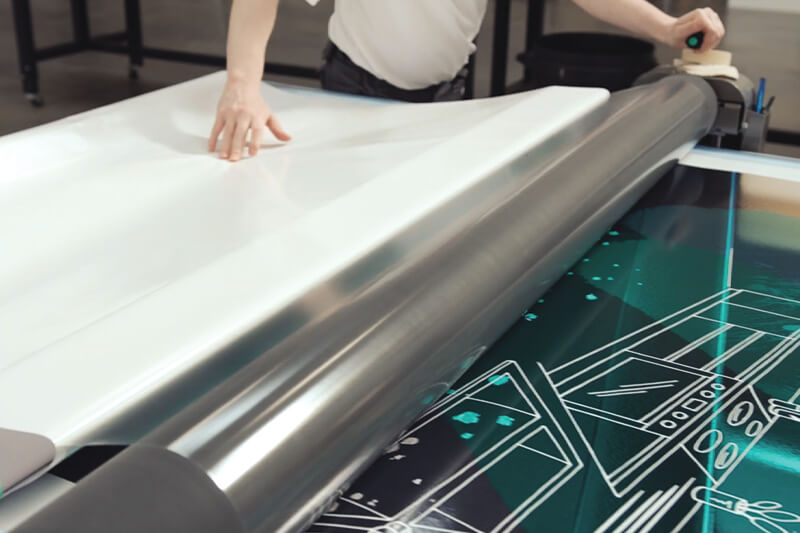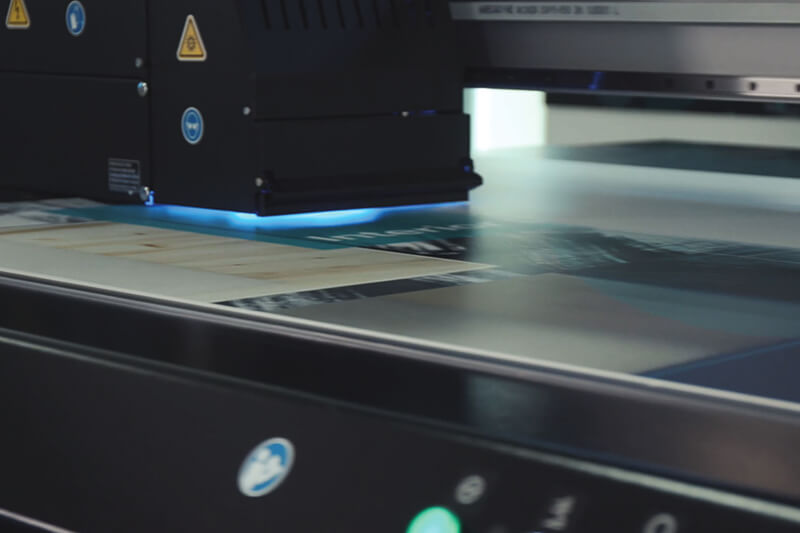You don’t need to be a Master of Economics to understand that you can make more money if you sell more products. With easier access to online selling platforms and a diversifying customer base, finding business is easier than it’s ever been.
Inevitably many print professionals reach a point where they need to add printing capacity with additional equipment. Do you invest in more of the same, shift to something more industrial, or change the approach entirely? Making that decision is difficult; a poor investment choice can have serious repercussions on the growth of a business.
Since it’s impossible to make the day longer than 24 hours, investing in a more efficient production method is critical. Let’s look at one of the most prevalent wide-format print products and examine the production method for a common application, printing on display boards.

Pictured: Applying laminate to printed roll-to-roll output.
Printing Rigid Boards with Roll-to-roll
Roll-to-roll wide-format printers are the first choice for most small-to-medium print businesses. Producing a rigid board for a building site hoarding or an event space is a three-step process:
1. PRINT THE ADHESIVE MEDIA
Once the media has been loaded and the device has been configured, the printing process can be fairly fast with the right equipment – especially if you don’t print in high-quality mode. Once the output is printed, you may need to wait until it is ready for application, depending on the ink you use.
2. LAMINATE THE OUTPUT
For outdoor work, permanent fixtures, or floor graphics, it’s recommended practice to cover the print with a film of protective laminating material. To do this effectively on a large piece of work, you will need a special laminating bench, including a full-width heated roller. Even with this method, bubbles and creases are not unavoidable, but it is more reliable than trying to laminate large sheets any other way.
3. APPLY TO THE BOARD
Now that the media is laminated, the next step is to apply it to the rigid board. Once again, the roller on the application table makes this much easier and less prone to costly mishaps.
A skilled operator or two can produce around 3-4 boards per hour using this method. Eventually, your business can only increase its output by increasing the number of devices and hiring more operators, which means investing in larger premises with higher overheads.

Pictured: Printing directly to a board with a flatbed UV printer.
How Flatbed UV Makes Board Printing Faster
The UV flatbed printing process is easier to describe because it’s much shorter. First, you place a board on the bed, then you hit “print” on your RIP, and after a few minutes, you remove the finished board and repeat the process as many times as you need to.
With this method, you can produce up to 4 times as many boards, extending even further by using lower quality print modes. This massive increase in productivity leaves your operators free to take care of other responsibilities whilst the printer completes each job. Not only does this boost your production of rigid boards, but you also have more flexibility to explore other opportunities to increase your bottom line.
This means that you don’t need to replace your existing roll-to-roll print devices – you can continue using them to produce additional products which enhance your service offering. Check out our article on generating profit with a printer/cutter to get some more ideas.
The fact that flatbed UV devices print faster is only one way accelerate the workflow. Vacuum bed technology holds the media firmly in place with the touch of a button, speeding up the set-up process and reducing errors. Positioning pins and on-bed guides help with quick alignment. The ink technology itself means that the ink is cured instantly with low-temperature lamps which don’t discolour the media like other direct-printing technologies.
Once you’ve made those gains in production speed, there’s no telling how far you can take your business. If you want some ideas to help you fill your time with business development activities, we have put a quick guide together here, or if you want to talk to an expert about flatbed UV printing, complete the form below, and we’ll be in touch.
Future-Proof Your Business
Click here to find out more about our IU-1000F UV-LED High-Productivity Flatbed Printer and the benefits it could provide to your business.
